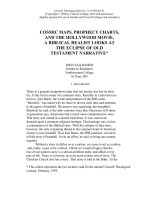FREQUENCY TABLES, BAR CHARTS AND CARROLL DIAGRAMS WORKSHEET
Bạn đang xem bản rút gọn của tài liệu. Xem và tải ngay bản đầy đủ của tài liệu tại đây (1.43 MB, 17 trang )
Frequency Tables, Bar Charts and Carroll Diagrams
Worksheet 1
A frequency table is a method of organizing raw data in a table by displaying a
series of outcomes in ascending or descending order, together with their tally and
frequencies—the number of times each score occurs in the respective data set.
Constructing frequency table with ungrouped data
First watch these two videos:
/> />
2. Here are the colours of 40 cars in the school car park:
Red red blue green white red
Blue red red blue white green
Red white white blue red white
Blue blue green black white blue
Red silver silver blue red red
Silver white white red blue green
Red blue silver white
P a g e 1 | 17
(i) Copy and complete the tally chart below:
Colour of Car Tally Frequency
Red
Blue
Green
White
Silver
Black
(ii) What is the most popular colour? ____________________________
(iii) Which colour represents 25% of the total cars? _______________________
3. The information shown displays the colour of 30 counters in a bag. Complete the
tally chart.
Car Colour Tally Frequency (Total)
Green
Grey
Yellow
Red
Black
Blue
White
Using the Frequency table answer these questions:
a) How many counters are Grey? ____________________
b) How many more Red counters than White counters are there? _______________
c) Which is the most popular colour? _______________________
P a g e 2 | 17
Worksheet 2 Constructing bar charts with ungrouped data
/> />
Complete the following bar charts:
1) Favourite Pet Snake Dog Fish Cat Bird
5 7 10 4 3
Frequency
Complete the bar chart below.
People’s favourite Pets
10
8
Frequency 6
4
2
0 snake dog fish cat bird
Type of pet
2.
P a g e 3 | 17
3) Favourite Sport football tennis netball hockey rugby
20 16 15 18 10
Frequency
Draw the bar chart on the grid below.
4) Favourite Subject English Maths PE French History
9 13 8 2 10
Frequency
Draw the bar chart on the grid below.
P a g e 4 | 17
5) Favourite Food Pizza Pasta Chips Curry Salad
12 8 15 9 4
Frequency
Draw the bar chart on the grid below.
P a g e 5 | 17
Worksheet 3 Constructing frequency table with grouped data
/> />
1. The ages in years, of 40 people, are shown below.
43 24 33 26 35 15 27 34 19 20 42 49 34 56 37 19 21
50 39 29 57 30 28 26 18 20 34 3 33 10 1 27 12
11 7 25 37 9 54 59
Copy and complete the grouped tally chart (frequency table) for the given data.
Age (years) Tally Frequency
0-9
10-19
20-29
30-39
40-49
50-59
(i) What is the width of each class interval? ___________________________
(ii) How many people are less than 20 years old? ______________________
(iii) How many people are 40 years of age or older? _____________________
P a g e 6 | 17
Worksheet 4 Constructing bar charts with grouped data
/>Work out:
P a g e 7 | 17
P a g e 8 | 17
P a g e 9 | 17
Worksheet 5 Carroll Diagrams
/>Carroll diagrams take sorting data a step further, sorting objects or numbers into
four boxes. Each box has to follow two criteria. For example:
Sometimes, Carroll diagrams involve numbers.
How to fill in a Carroll Diagram?
Example, sort the numbers 8, 22, 18, 49 and 100 into the Carroll diagram:
1. Deal with one number at a time.
2. For example: look at the number 8.
3. Go through each of the criteria, in turns, to work out which box it should go in.
4. Then cross off number 8 from the list.
5. Next look at 22 and do the same, and so on.
P a g e 10 | 17
P a g e 11 | 17
56
P a g e 12 | 17
P a g e 13 | 17
1. Fill these numbers into the Carroll diagram, then add your own numbers.
7, 16, 21, 12, 25, 150, 76, 34, 2, 129, 27, 66, 240
Odd Not odd
Multiple of 3
Not a multiple of 3
2. Put the following numbers into the correct place:
54, 2, 19, 44, 24, 13, 4, 41, 16, 35, 36, 60.
Multiple of 4 Not Multiples of 4
More than 30
Not more than 30
P a g e 14 | 17
3. Put the following numbers into the correct place:
21, 99, 28, 66, 81, 36, 29, 18, 32, 42, 52, 17, 34, 91.
Multiples of 7 or 9 Not Multiples of 7 or 9
Less than 45
Not less than 45
4. Can you think of 4 numbers to go in each section? Not Multiples of 2
Multiples of 2
Multiples of 5
Not Multiples of 5
5. Can you draw two shapes to go in each section? Not Quadrilateral
Quadrilateral
Has at least one line of
symmetry
Has no lines of symmetry
P a g e 15 | 17
Interpreting Carroll Diagrams
P a g e 16 | 17
Learning Outcomes
I can construct a frequency table with grouped and
ungrouped discrete data.
I can construct a bar chart using grouped or ungrouped
discrete data from a frequency table.
I can interpret data from frequency tables and bar charts.
I can complete and interpret a Carroll diagram.
P a g e 17 | 17









